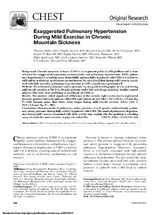Exaggerated pulmonary hypertension during mild exercise in chronic mountain sickness
Fecha
2010-02Autor
Stuber, Thomas
Sartori, Claudio
Schwab, Marcos
Jayet, Pierre-Yves
Rimoldi, Stefano F
Garcin, Sophie
Thalmann, Sébastien
Spielvogel, Hilde
Salinas Salmón, Carlos E
Villena, Mercedes
Scherrer, Urs
Allemann, Yves
Metadatos
Mostrar el registro completo del ítemResumen
Background: Chronic mountain sickness (CMS) is an important public health problem and is characterized by exaggerated hypoxemia, erythrocytosis, and pulmonary hypertension. While pulmonary hypertension is a leading cause of morbidity and mortality in patients with CMS, it is relatively
mild and its underlying mechanisms are not known. We speculated that during mild exercise associated with daily activities, pulmonary hypertension in CMS is much more pronounced.
Methods: We estimated pulmonary artery pressure by using echocardiography at rest and during
mild bicycle exercise at 50 W in 30 male patients with CMS and 32 age-matched, healthy control
subjects who were born and living at an altitude of 3,600 m.
Results: The modest, albeit significant difference of the systolic right-ventricular-to-right-atrial
pressure gradient between patients with CMS and controls at rest (30.368.0 vs 25.464.5 mm Hg,
P5.002) became more than three times larger during mild bicycle exercise (56.4619.0 vs
39.868.0 mm Hg, P,.001).
Conclusions: Measurements of pulmonary artery pressure at rest greatly underestimate pulmonary artery pressure during daily activity in patients with CMS. The marked pulmonary hypertension during mild exercise associated with daily activity may explain why this problem is a leading
cause of morbidity and mortality in patients with CMS.

